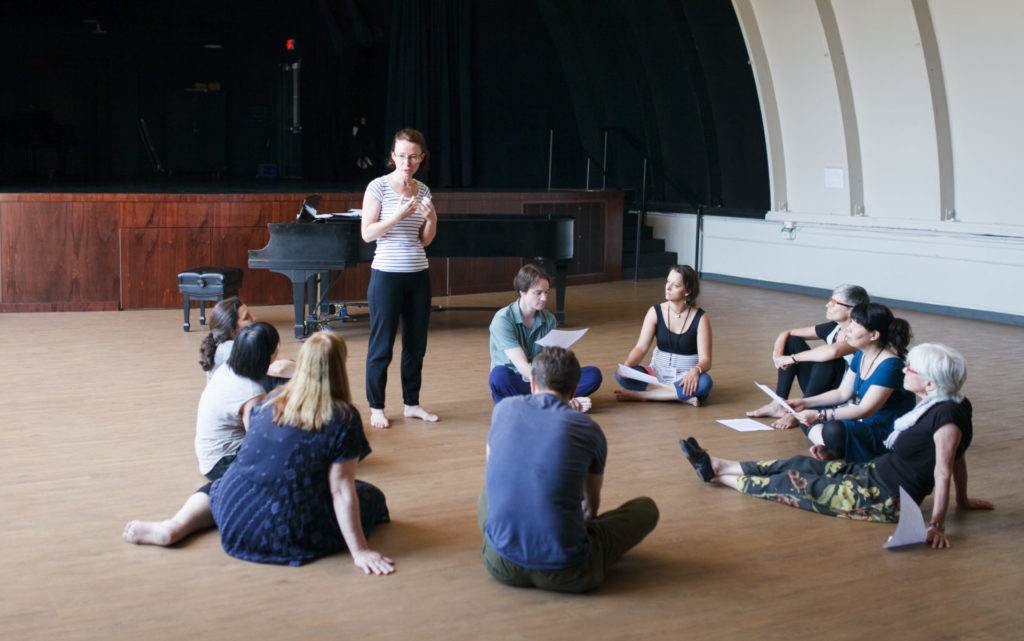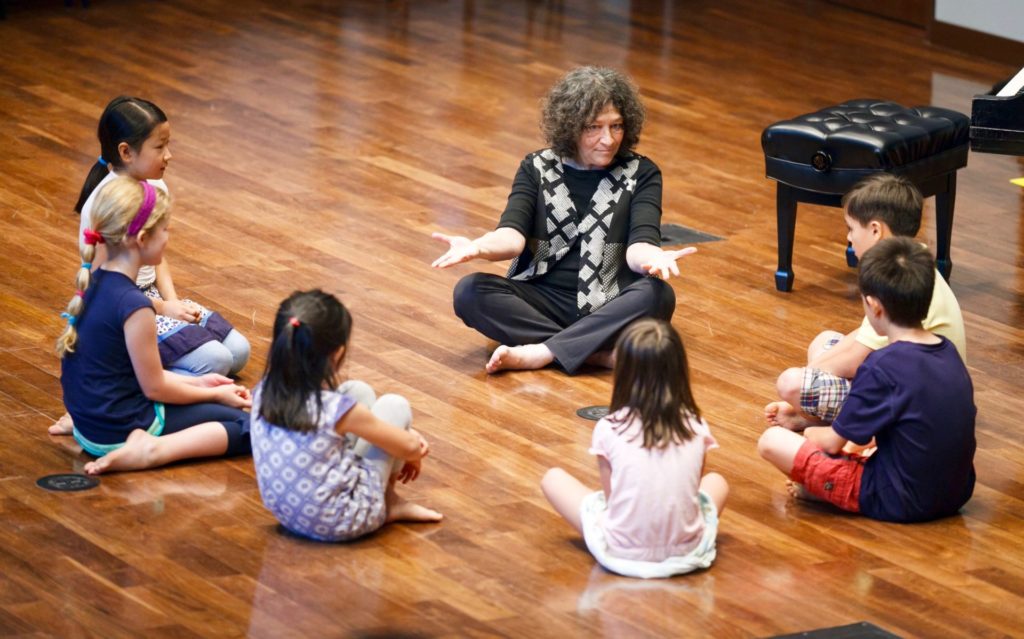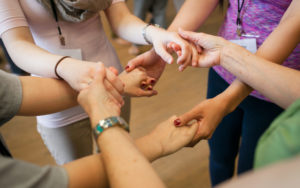
Building Global Connections: A Conversation with Silvia del Bianco
This conversation took place in November 2015.
Director of L’Institut Jaques-Dalcroze since 2006, Silvia Del Bianco holds a singular position in the global community of Dalcroze practitioners. Yet many of us in the United States know precious little about her or the institution she heads. So I’m excited that we are featuring a conversation she and I had via Skype this past November [2015], a few short months after I saw her at the International Dalcroze Congress. Our talk gave me a chance to get to know her better. She shared with me how she envisions the role of the Institute, in relation to the international Dalcroze scene, to be sure, and also in relation to the American community of practice.

Young students in a Dalcroze class watch their teacher closely.
“A language that’s not a language”
William Bauer: Two years after earning your Diplôme you were invited to join the College. And you were quite young still.
Silvia Del Bianco: I was just thirty-one. I was extremely surprised. I was the youngest for quite a long time. I asked myself, “Why are they asking me?” At that time I didn’t have a very strong background in Dalcroze Eurhythmics. I’m not a person who had just come from the music school in the Institute. The first time I did eurhythmics, I was twenty-six. I came with a background as a musician—when you start doing eurhythmics relatively late in your development, you ask yourself a lot of questions: Why does it work like that? Why should a musician do it? What should I change? How do I explain it so it makes sense for a musician, and for an adult, to start doing all those movements? I think that was an important element for them.
Very soon after I finished my Diploma I was asked to join the school in Biel, in the canton of Bern where the Institute had a satellite program; students there could pursue their training for two years before fulfilling the residency requirement in Geneva. When I joined that team, they decided they were going to separate from the Institute. Coming from a Swiss-German background, they were interested in exploring what possibilities there were to develop other applications of eurhythmics.
I found myself in a context where I was the only Dalcrozian in a group of people who were even integrating other methods. We had a Kodály teacher, Edgar Willems for the solfège, in French, and we had Orff as an elective. That experience was very interesting for me, because you need to find your place in a context that is made of different identities.
When you work in a context where we are all Dalcrozians, it’s not so necessary to explain what you’re doing; we understand us among us; we have a special language that’s not a language. I found it very interesting to work with people who came from such different backgrounds, and for them it was not so obvious why the label “Dalcroze” was so important.
I see what you mean. It makes you think about how others from different musical approaches would perceive what we do and helps to build a bridge to it.
Exactly! The idea of the bridge is extremely important. We need to be very humble to see that even if, for ourselves, what we do is the best, we need to accept that it is one way to come to it, but it’s not the only way. Other people have different ways to come to this knowledge, and to the practice, and to the creativity, and to improvisation. We can come together with a specific goal, which is to help the student go further in his development and to help him find a way to be most useful to others.
Yes. Going along with what you’re saying, each approach has its strengths and weaknesses, so we can be very complementary. I find that, working with Suzuki people, Dalcroze can fit like a hand in a glove.
 I can understand. For me it was very rich to work with the Kodály people, because of the voice—the use of the voice, even the fixed “do”/not fixed “do” debate, different ways of teaching. It was very good to work with some of the people who were doing Taketina [recently, the Swiss Dalcroze practitioner Fabian Bautz shared this with us here in the USA] and others who teach rhythm by moving in place rather than through space. Once when we were preparing a demonstration with other teachers, I found it very interesting that I hadn’t realized my students could do very complex polyrhythms, three against four, etc., when they were just standing in one place and they moved focusing on the vertical impulse, like African dance, just with body percussion; but when I had them take it through space, going forward and backwards, including the horizontal impulse, and using tambourin, it was difficult for them. I discovered just how important this concept of using space is. Not just standing in one place, but using it. Because when you need to work with the weight of the body, and when you get involved in moving in the same room among other people, it brings another level of complexity. It becomes a different exercise.
I can understand. For me it was very rich to work with the Kodály people, because of the voice—the use of the voice, even the fixed “do”/not fixed “do” debate, different ways of teaching. It was very good to work with some of the people who were doing Taketina [recently, the Swiss Dalcroze practitioner Fabian Bautz shared this with us here in the USA] and others who teach rhythm by moving in place rather than through space. Once when we were preparing a demonstration with other teachers, I found it very interesting that I hadn’t realized my students could do very complex polyrhythms, three against four, etc., when they were just standing in one place and they moved focusing on the vertical impulse, like African dance, just with body percussion; but when I had them take it through space, going forward and backwards, including the horizontal impulse, and using tambourin, it was difficult for them. I discovered just how important this concept of using space is. Not just standing in one place, but using it. Because when you need to work with the weight of the body, and when you get involved in moving in the same room among other people, it brings another level of complexity. It becomes a different exercise.
New Pathways
Silvia del Bianco: In terms of the various projects at the Institute, and the new applications of eurhythmics, my main idea in that is to get involved in projects with the scientific world. For that we’re working closely with the Department of Neuroscience in the University of Geneva. They helped us with two projects we were working on, and we did a small research project with them as well. I think it’s very important to get involved with the medical people in terms of seniors, Alzheimer’s, Parkinson’s and other diseases and situations where eurhythmics could be a help. Our partner in this field is the University Hospital in Geneva. I’m not considering eurhythmics as therapy. It’s well known that music and movement activities can help to maintain and improve the quality of our lives. So those could be very good applications of eurhythmics that were not so well known until now.
William R. Bauer: I agree, and I’m thinking, when you say “not therapy,” you want to be clear, we can make no claims to heal people directly.
Exactly! We can’t heal people, but we could work together with doctors, so we can have better results. Because they have the knowledge we don’t have, and they can help us identify the type of activities that make people in this situation go further, have less pain, or be able to take fewer drugs. For us the collaboration with doctors this year was very important, because they told us immediately which Dalcroze exercises and aspects [of the practice] helped people make progress or feel more lively.
What you’re talking about is supporting people’s wellbeing.
Exactly. When we had the project with Alzheimer’s patients for a year, it’s not that we healed. We didn’t heal. But the wellbeing was at the end of every lesson. The week after, someone from the family would come and say, “She was calmer. She was more receptive. We had the feeling that she was not angry, and perhaps she could sleep better.” Those are very tiny things, but they count a lot.
Absolutely. It almost creates a framework for healing to take place.
Exactly.
It’s really admirable that you’re cautious about this point. Obviously there are legal issues, but moreover credibility issues. There are people out in the world making all sorts of claims about causing or influencing results that they can’t support with evidence.
“It Comes to a Point Where Changement Is Needed.”
Silvia Del Bianco: Bill, in your email you asked me if I have specific insights or feelings to share with the American community of practitioners. I’m not somebody to give advice, so it’s not meant in that sense; but I should say I admire a lot what America has done to develop eurhythmics, in very different ways, with different…colors, I should say; because the various personalities of Dalcroze your teachers could be complementary. You have had a very long, solid history. I respect that. There is a lot of work that has been done to make it what it is now.
I think when problems come, as they did, when people think they want to be more free to do this thing or other, well, perhaps it’s a better solution to have two groups. That is the reality of Switzerland, too. We have a Dalcroze society and we have the German part of Switzerland that has a Eurhythmics society. In my opinion some points are essential: to have respect for what people do, not to judge them too quickly or easily and to still come together and dialogue.
William R. Bauer: I appreciate your saying that. I’ve been trying to provide a modulating influence over the development of the AES formed by David Frego and Kathy Thomsen. As you were saying about yourself, I feel I’m in the right place at the right time.
I can imagine.
Because I’m setting a tone in the discussion that is respectful…
Exactly.
…but I’m also trying to help them be clear about what they are communicating.
Exactly. I think these two points are very important, and make it possible to have a dialogue, to communicate, as you said.
I noticed a few years ago that you gave a workshop somewhere with Reinhard Ring…
Yes.
…and that spoke volumes to me about your ability to build bridges across what may be difficult areas.
I work a lot with the German people, who do not use the name; and it was even funny, sometimes, they said to me “I don’t think you’re Dalcrozian”; but sometimes they were against something without really knowing what it was. But it was extremely helpful to work together, to see what one person could do and what the other could do, and where each was at their best. Because, as you said, we all have our weak points and our plus fort [strong points]. It’s very important to have those kinds of relationships.
If I had a wish for the Americans, it’s to consider the huge history that you have, be proud of that history and of being able to produce what you did in all those years. But perhaps to accept the situation now. It comes to a point where “changement” or evolution is needed. And to be able to work together. It doesn’t mean you do the same thing; to consider that they go in different ways, and to accept it. To see what we could do in common. And perhaps you come to the decision that it’s not possible—but it’s a reality.
Also because we’re each filling different gaps in our society.
Yes.
I think for the American community to read your words will be inspiring. My hope is to work with [DSA Vice President] Jeremy Dittus to build a stronger bridge with Geneva, so our younger students can travel over and get the Diplôme, and become trainers. We need those desperately, as you know.
For the Diplôme, there are a lot of things that have been arranged in terms of being able to do a part of it in America with the supervision of Diplôme teachers over there. Being able to do some exams through Skype, or part of an exam through Skype. We will keep moving forward and thinking about these kinds of possibilities.
That’s exciting. Until now it has seemed like an impossibility. But when I came to Geneva this summer, I felt a breath of fresh air, in terms of what could happen. Thank you so much for taking the time to speak with me.
Thank you for the time we shared.
This article was originally published in the Fall 2015 issue of Dalcroze Connections, Vol. 1 No. 1.